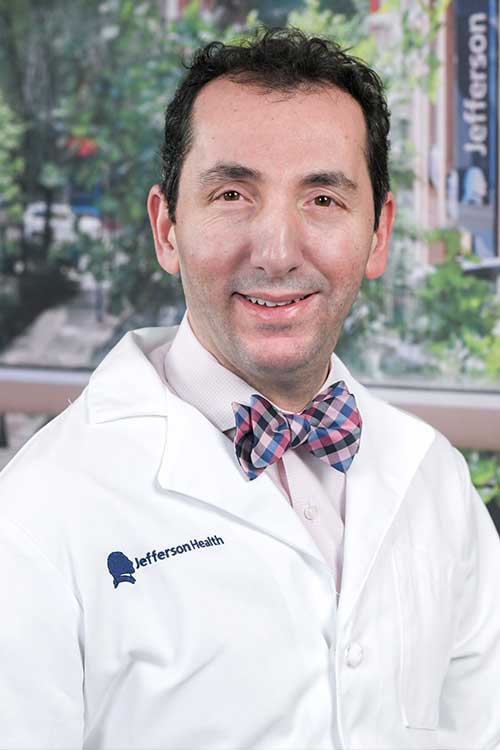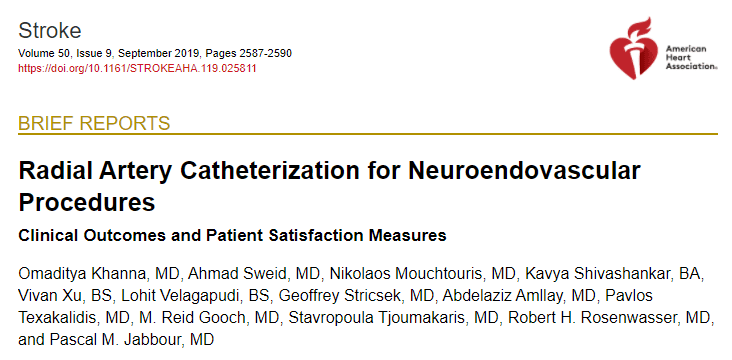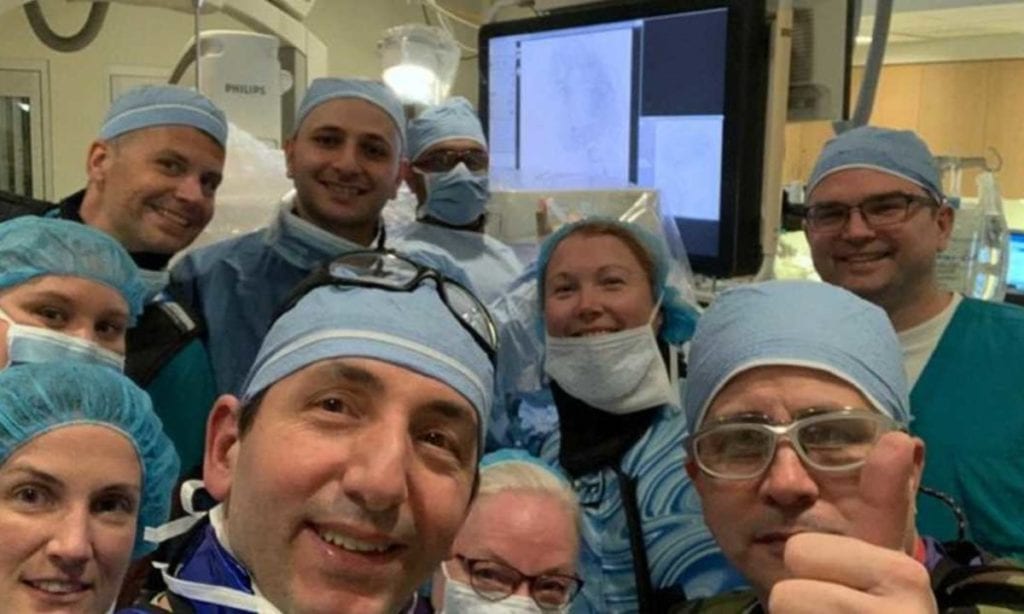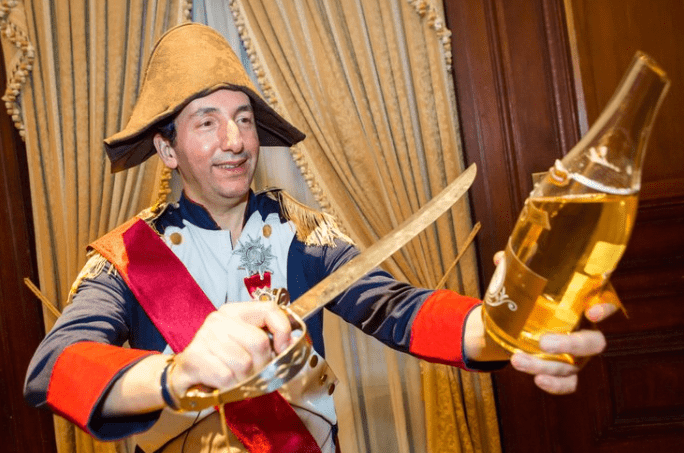
Pascal Jabbour, MD, is a Professor of Neurological Surgery and the Head of the Division of Neurovascular and Endovascular Neurosurgery in the Department of Neurological Surgery at the Sidney Kimmel Medical College at Thomas Jefferson University. He is a dually trained vascular neurosurgeon performing endovascular and open procedures.
This interview was initially meant to be released as a podcast, but the audio file corrupted! Thankfully we could transcribe some of the audio to bring you these pearls of wisdom.
In this interview at EANS last year we talked about comprehensive vascular training for neurosurgeons as well as finding out about Prof Jabbour’s accreditation as a level III wine sommelier and some wine buying tips at the end!
AA: I’m very happy to say that I have Professor Pascal Jabbour with me, who is a dual trained neurosurgeon, neurointerventionalist in vascular surgery from Thomas Jefferson [Hospital], who has kindly agreed to give me 25, hopefully 30 minutes of his time to talk about everything from comprehensive vascular neurosurgery to his love of wine and being a sommelier.
PJ: Hey Alex, thank you for having me, it’s a pleasure.
AA: Thank you. So, we’ve talked briefly about the fact that in the United Kingdom we can’t really train as hybrid vascular neurosurgeons yet – hopefully one day we might be able to. You specialise almost in trans-radial access to the brain. Do you want to talk to us a bit about how you have come to do that?
PJ: First of all, it’s a shame that you are not able to do dual training in the UK because… to be able to be objective and to be able to advertise for a disease and not for a tool, you should be able to be proficient in both. Because you don’t want to go and say “I can clip aneurysms” or say “I can coil aneurysms”, you need to be able to go and talk to a patient and say “I’ll be able to take care of your aneurysm. If it needs an open surgery or if it needs an endovascular procedure, I will be able to do it”. It’s a little bit like a neurosurgery residency – if you look to 15 or 20 years ago, they didn’t used to do instrumentation of the spine, right? This used to be just an orthopaedic thing. If you look at it now, you don’t say “I’m a dually trained spinal surgeon”, because now everyone puts pedicle screws and can instrument the spine. But they had to fight a long time ago to be able to incorporate this in the curriculum for the neurosurgery residency. This is what it needs, it needs leadership in neurosurgery, it needs someone visionary who will be able to do this. I was lucky to be trained by, really, by the best person who introduced endovascular neurosurgery to the neurosurgeons – Dr Robert Rosenwasser. He was the first officially dual trained neurosurgeon in the US, if not in the world actually. So I trained under him and this is how I became a dual trained neurosurgeon. I did my residency at Jefferson, I did my fellowship there and I stayed on board. It makes sense, I mean, as I said – if my tool is a hammer then everything else is a nail. We don’t want to do that. When I sit down and talk to the patients, I know that the patient realises that regardless what the procedure is going to be, I’ll be taking care of it and I won’t be biased in trying to push the envelope one way or another to keep the patient here.
…you need to be able to go and talk to a patient and say “I’ll be able to take care of your aneurysm. If it needs an open surgery or if it needs an endovascular procedure, I will be able to do it”.
-Professor Jabbour
Let’s move to the transradial part, transradial is my passion and has been my passion for the last 2 years and it makes a lot of sense, because the literature is there. I mean we are lucky to have all the cardiology literature. As you know there are a lot of cardiology patients, so whenever the cardiologists want to enrol in a trial, they can enrol thousands of patients really easily. Not like in neurosurgery. If you look at the literature, there are a lot of trials and thousands of patients. There was a Cochrane review, there were 30,000 patients they looked at. They were able to correlate a transfemoral approach with decreased mortality and decreased morbidity. Now we’re not talking patient satisfaction, we’re talking risks and complications. I just published a paper in Stroke and we talked about patient satisfaction. I sent a questionnaire to patients who already had a transfemoral procedure and later on we did a trans-radial. Across the board, everyone would rather have a trans-radial approach. So less risk, the patients will spend an hour in PACU and go home, instead of spending 4 hours flat.

The PACU nurses and everyone says it’s a good use of resources, and it makes more sense – the patients can stand up and walk right away so early mobilisation of the patient. When you’re working out the risks, there is nothing you don’t know there. There’s no – I call it like the “black hole” or the “black box of the retroperitoneal haematoma”. I mean no-one knows what’s happening there. I do a transfemoral angiogram, if the patient is a little bit hypotensive after the procedure you then go and get a CT abdomen/pelvis, you’re going to check haemoglobin and you’re worried. Here [with transradial access], everything is there. It’s the risks and you can see them, it’s nothing to guess. Now why is there resistance against this? Because first of all, it’s more challenging for the interventionalist and because practically none of us were trained in transradial, everyone was trained [in] transfemoral so it’s going to be a little bit more challenging. You need to commit for at least 50 – 100 consecutive cases to be able to figure out the ins and outs of it. Some people would tell me “oh you know, if the arch is difficult we’ll do transradial”. Well, we’ve been through that, we’ve tried it, it’s gonna be a big production. And every time it’s a big production when you’re doing transfemoral and suddenly you want to do transradial. Everyone is not used to it, you don’t know how to position the patient, you tilt the table, so… You need to commit to 100 procedures.
AA: It’s the fear of the unknown isn’t it?
PJ: Yeah. And then at this point unfortunately technology is working against us because all the tools that are available, all the catheters – they are for transfemoral, not for transradial. So we really need to sit down and work with the industry to be able to design new catheters to help us a little bit in that.

AA: Okay, fantastic. So do you think that one day transradial might completely replace transfemoral?
PJ: So I think at this point…. I would like to get more people trained in transradial. Like my fellows that I trained last year, they graduated – I joked and put a post on social media. I said “The first generation of transradial, they just graduated”. And they loved it, they sent me pictures of what they were doing and everything. I mean, I don’t think at the end it’s going to be 100% transradial, it’s like everything in medicine – it’s gonna be balanced. People need to be proficient in both techniques. For example, in my practice – they only case that I still don’t do transradial are left sided ICA territory stroke, if the ICA is not bovine. If the ICA is bovine, if the carotid is bovine, at the time its easy, straight shot – you go transradial, you go up, you don’t even need a Simmons Catheter. But if it’s a regular internal carotid artery I wouldn’t go transradial. Not because I’m not able able to do it, but because when we looked at our series, that’s the highest conversion rate if you’re going on the left side. And you know in stroke you cannot afford wasting time to convert. If it’s an elective procedure, fine – you’ll do it and if it doesn’t work you go transfemoral. At this point all my practice is transradial, only left territory stroke is still transfemoral.
AA: Brilliant. Now you mentioned fellows and obviously when we as UK residents and even attendings (or consultants) are thinking about the possibilities of dual training at some point, you start to think “okay I’ll require maybe one year, maybe two years, or maybe even a little bit longer”. Do you think a one year combined open and endovascular fellowship is enough to be proficient?
PJ: So depends on the centre and how busy they are. For example at Jefferson we’re very busy and our fellowship is a combined open and endovascular [one]. You can do it in one year if you already come to us and you’ve already done 300 diagnostic angiograms. And these days nearly everyone is able to do it. So practically what happens is when they come to interview for the fellowship (and we interview 2 – 3 years in advance)…. The majority of them will have done during their residency 300 diagnostic angiograms. But whoever didn’t do that, we tell them during the interview that they still have 2 – 3 years to do it so make sure you come to us and you’ve already done 300 diagnostic angiograms. Then all our fellows, they graduate in one year and they are proficient in both.
AA: So you give warning shots at least! So it is possible and you need to do some homework before you start this fellowship.
PJ: Now we also have some fellows who were practicing neurosurgeons for 5 – 10 years and they decided to do a fellowship. Those fellows also have practices in their hospital so they come to us part time. We have people doing it one week on, one week off. Those fellows, they don’t need open surgery because they are open neurosurgeons, so those also do it in 2 years because they are doing it part time.
AA: Do you have any advice for budding comprehensive vascular neurosurgeons?
PJ: So… you know, it’s funny you said “comprehensive vascular neurosurgeons” and I know what you meant – that’s what we are trying to do. We don’t want this “comprehensive” vascular neurosurgeon, we want “vascular neurosurgeon” means being able to do open and endovascular. Same analogy – you don’t say “comprehensive spine surgeon” to mean this surgeon is able to instrument and to do regular decompressions. So my advice to them is to try to fight for their dream. If they want to be a dual trained neurosurgeon and it’s not available in their country, try to go to the US or to any country where it is available. Then try to push the people in their own country to change the laws if there are such laws. I mean if I think about it, if there’s such a law I would think the people that are against it are people that were trained a long time ago and they are open surgeons, and they don’t want to open this to neurosurgeons to be endovascularly trained. And it can be from both sides – from the interventional radiology side and from the neurosurgery side. I mean this needs to happen and it will happen, it’s just a matter of time.
AA: Yeah, so essentially it’s chase your dreams.
PJ: Be passionate about it.
We don’t want this “comprehensive” vascular neurosurgeon, we want “vascular neurosurgeon” [which] means being able to do open and endovascular. Same analogy – you don’t say “comprehensive spine surgeon” to mean this surgeon is able to instrument and to do regular decompressions. So my advice to them is to try to fight for their dream.
– Prof. Jabbour
AA: Absolutely. Talking about passions – I think that brings us nicely about what I really want to talk to you about. And that is your love of wine. Can you tell me a bit about being a sommelier?
PJ: Yeah, so… recently I went to wine school and I just graduated as a level 3 sommelier. In February I am going for the advanced higher degree. I am a passionate wine lover, a wine collector, it started since I was young. My parents and my grandfather (who raised me) used to give me when I was growing up some wine and let me taste wine. Not sure if you’re gonna cut this part or if you’re gonna keep it!
AA: We’ll keep it!
PJ: So this is how my love for wine grew. The main reason is it’s so subjective. You put a glass of wine and you ask people to taste it and each oen will give you something different. No one is right and no one is wrong. It’s just you go with your imagination and you keep on going. Wine is something really… there’s a mystery around wine. Always growing up, I used to think what kind of red liquid is that, that you put it in a bottle and you leave it, you forget about it for 20 – 30 years and you don’t know how it’s going to taste. You taste the bottle 5 years after the vintage was out it’s going to taste like something, then 10 years later it’s gonna taste something different… you’re gonna have flavours that were never put in the wine, you know? You know how wine critics use words like “cigar box”, “old leather”, “book case”, “cassis”, “fresh fruits,” “dried fruit”, “strawberry”….no one puts strawberry in the wine, no one puts dust in the wine or earth in the wine. But yet those flavours came in so some kind of magic is happening for that! So I think it’s also what I like in wine – it’s a nice thing to gather friends and family to share a bottle. I would never open a nice bottle and drink it by myself. I wouldn’t enjoy it, really. I would rather maybe drink a cheap bottle of wine, but to have friends with me and discuss it and enjoy it…. Really good wine is made to be enjoyed with friends and to discuss it with friends.

AA: I completely agree
PJ: When I was a medical student and then a resident I started collecting some wine. At the time I couldn’t collect high end wine at the time but I started collecting wine. I used to put them in a room in the basement and just stack them up. Then when I started practicing, slowly I was able to go further in my hobby of collecting. I was able to build a wine cellar.
AA: Lovely, that’s the dream!
PJ: Then I thought that, “Well I want to try… there’s no real science behind it but I want to try and go behind the science. Yeah I can enjoy wine and everything but I want to pursue it in a professional way.
AA: I saw on your Instagram recently that you were starting your own-
PJ: Yeah so we were branding our own barrel in Bordeaux with the Chateaux Lynch-Bages and this was a nice blending session. We’re still learning and it’s very interesting. I’m lucky also to belong to a really big wine club in Philadelphia. I organise wine events, I’m on the executive committee of the wine club. Another hobby of mine is to saber champagnes. I’m a champagne saberer, which means I open the bottle with a sword.
AA: It scares me, the idea!
PJ: Haha yeah. This was how Napoleon used to do it a long time ago. So I think in the field that we are in, everyone needs to have something to decompress, you know. It can be spending time with family, with friends, having outside hobbies.
[Playback stopped then resumed!]
PJ: I’m learning that… I’m starting to enjoy a pinot noir. I’m also a big fan of Californian Cabernets, the big old Californian Cabs. But Bordeaux will always be my favourite.
AA: So what do you think… Because I was in Tuscany recently, obviously you know about all the Super Tuscan wines. But the Ornellaia was gorgeous…
PJ: Ah yeah the Ornellaia
AA: I had my first Ornellaia 2 weeks ago with my wife and it was incredible. We both just sat there smelling it for about 20 minutes, and then we drank it. What do you think of them?
PJ: So it’s funny, because… In general, I don’t drink a lot of Italian wines but my favourite of them is the Super Tuscan. And it makes sense because the Super Tuscan is a Bordeaux blend and when Italy wanted to do a Bordeaux wine they created a Super Tuscan. So I also like Amarone, Amarone is a nice wine… It’s really, Amarone takes a lot of work to do a good nice Amarone. It’s really a witness of the skill of the wine makers so I like Amarone. But yeah the wines that you mentioned… are all lovely.
AA: So I’m collecting Amarones, do you have a tip for me? Any specific year?
PJ: See, I’m not an Amarone specialist, I just enjoy Amarone!
AA: Oh no! Okay, a tip for listeners – if there’s one bottle of relatively affordable wine that they could go for to maybe start their cellar, what would you suggest?
PJ: A brand, a bottle?
AA: Yeah, or maybe a specific year if you have an idea of one.
PJ: So the Bordeaux 2009 was a really spectacular year. The 2010 that came after was also a good year. But any bottle of 2009 will age really good. 2009 was more wines got 100 Robert Parker scoring in 2009 in Bordeaux than any other vintage. And you don’t have to buy an expensive one, anything that you can find you should buy it now. 2015 is also a really good year, so I would buy 2015. Again, Bordeaux has a big range – you can go from a wine for $20 – $30 to over $1000. All those wines can age but again as I said, just enjoy wine, it doesn’t have to be an expensive bottle. Actually anybody can go buy a really expensive bottle then enjoy it, but I think the most difficult thing is to really find an affordable bottle when you can enjoy it. One of our events in our wine club is we just grab a bottle that should be less than $20 a bottle and show us why you like it.
AA: Sounds good, that’s amazing! I think that finally – I don’t want to take up too much of your time – I’ve been talking a bit more on Brainbook recently about work-life balance and resilience. It’s just interesting that you mention about decompressing when we have such an intense job. Do you find that the training to become a sommelier or even your love of wine, spending that time… do you find that it does anything for your practice as a neurosurgeon? Do you think it imparts maybe more skills or makes you a more patient person? Or makes you more focused, or anything like that? Maybe it doesn’t?
PJ: I think, in general, learning in life is important. It makes you become more open minded. It’s good to keep on learning really. As you know in our field, it’s not that you start practicing, you graduate, that’s it. No, you keep on reading, keep up to date and I think to have the adrenaline rush of tests, of studying, you’re gonna be tested and they’re gonna score you… is also important. It keeps you really up to date, it keeps your mind really working and keeps the blood flowing. Not necessarily in wine but in general I would encourage my chairman went and did an MBA just after he accomplished all he accomplished he decided he wants to go and do an MBA. So I think continuous learning is really important, otherwise stagnation is not good at all.
AA: Fantastic. Thank you so much for your time today. Professor Jabbour is actually quite big on social media (I think) so just before we go I’m going to tell everybody (if you don’t mind) what your social media handles are just so people can follow you… Maybe the wine lovers out there can give you a follow. On Instagram it’s jabbour.pascal and on Twitter it is @pascaljabbourMD where you put up a lot more professional posts.
PJ: So I’m also on LinkedIn, they can search my name. Instagram I post surgeries and wine. Twitter I do only surgery, neurosurgery and articles. And LinkedIn only neurosurgery. Instagram is the one I post both.
AA: Fantastic. Thank you so much for your time and I hope listeners found that as interesting as me. I’m definitely going to go and find some 2009 Bordeaux’s – will start looking that up. Thank you very much for listening, thank you very much for coming.
PJ: Thank you very much Alex. I really want to congratulate you for all the effort you’re doing for the podcast and for your social media. I also follow you on social media and you have really good, nice material for all the medical students, residents and actually I was checking, I have a lot of MY residents following you on Instagram! So keep up the good work and I think you’re doing a fantastic job.
AA: Thank you very much and I hope you enjoy the rest of the EANS.

Leave a Reply